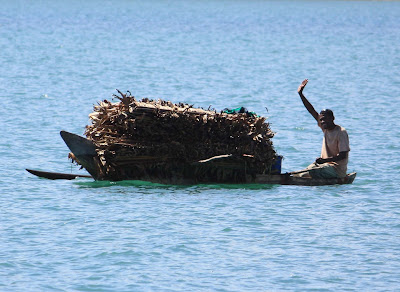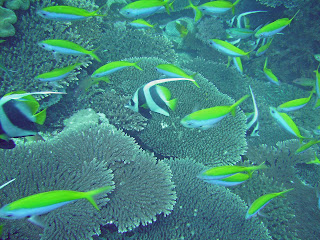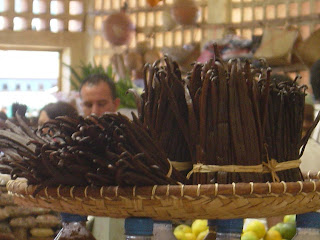We stayed in the first western bay after rounding the northern tip of Madagascar. There were no villagers here but the calm waters allowed us some much-needed rest. The winds were still a brisk 20 knots, but the protection of the bay kept the chop small and we did not roll at all. We had a few days rest and some rain cleaned away the salt spray. The weather was a pleasant change with nights down to around 70 degrees at night and we slept with a light sheet for the first time in at least 6 months. Emily and I ventured in to the barren volcanic shore and burned some plastic and trash below the high tide line. We saw a few spiders and saw some zebu at a distance. The zebus are the Madagascar cows and are distinctive with their large shoulder hump.
Kim cooked the monster octopus that we were given in Chagos and it was really good!
After 3 days, we made the long day hop down to Andranoaombi Bay which was the first stop with good protection. We had read previous cruisers logs indicating that there were villages here with which we could trade. We were in dire need for some fresh fruit and vegetables. Sure enough, we barely had the anchor set when a couple of women came paddling out with some limes. We did the best we could and traded way too many clothes for 4 eggs and some fruit. Another fellow came out with Papaya and more eggs and was rewarded with some spare rope. No money needed here as we were still a long way from an ATM.
The villages are very primitive and no lights other than cooking fires are seen after sundown. Huts are constructed of poles (small branches from trees) and then the sides and roof are covered with palm fronds. The fronds from the palms here are small and rounded, not long like coconut palms, so they are arranged in fan shapes in the walls. Everywhere we went women were winnowing a grain that looked something like barley.
Next stop was Nosy Mitsio (nosy is Malagassy for island).
There were more villages here but with the addition of a portable generator loud music disturbed the tranquil setting. We were really enjoying seeing the sailing dhows peacefully sailing up and down the coast.
We only stayed one night before dropping the hook just off the white sand beach of 5 star Tsara Bajina Constance resort. We enjoyed free internet on the boat and went ashore for several nice meals and cool drinks. The staff was very nice and even brought us a sim card from Hellville to get our cell phone working.
We stayed a few days and even splurged on a guided SCUBA dive off one of the Brothers islands which really was special since we were the only divers. The guide picked us up from Emily Grace on their dive boat and another guide drove the boat above us as we dove. The schools of fish were massive and large tasty fish like grouper and snapper came right up to us with no fear. It was tough to move on, but my credit card was still smoldering for several days after.
There were more villages here but with the addition of a portable generator loud music disturbed the tranquil setting. We were really enjoying seeing the sailing dhows peacefully sailing up and down the coast.
Dhows are a design which have been proven over many centuries. The lateen rigs they sport have powered untold numbers of working and war vessels continuously since at least the second century BC, and possibly for many thousands of years before that. The triangular sail lends itself to pointing - far more so than square rigs - and is used to this day for fishing, and to move people and goods around many parts of the Mediterranean and Indian Oceans. It's a design that works, in every sense of the word.
We only stayed one night before dropping the hook just off the white sand beach of 5 star Tsara Bajina Constance resort. We enjoyed free internet on the boat and went ashore for several nice meals and cool drinks. The staff was very nice and even brought us a sim card from Hellville to get our cell phone working.
We stayed a few days and even splurged on a guided SCUBA dive off one of the Brothers islands which really was special since we were the only divers. The guide picked us up from Emily Grace on their dive boat and another guide drove the boat above us as we dove. The schools of fish were massive and large tasty fish like grouper and snapper came right up to us with no fear. It was tough to move on, but my credit card was still smoldering for several days after.
We stopped in Befotaka Bay for one night and then Sakatia where we talked to some South Africans and tried to get some local information. It seemed that getting gas was going to be more complicated than pulling up to a gas dock here! We got a rugged description of the main town and hesitantly we headed to Hellville to check into Madagascar.
Some might say this small, run-down town with its crumbling-colonial architecture is aptly named. In fact, it is named for a French governor of Reunion, Admiral de Hell. We found the town eccentrically appealing and small enough to explore on foot, from the port through the old part of town with its vine-covered ruins and colonial buildings to the tiny "supermarket", banks, and market. The anchorage is a colorful, bustling place with dhows sailing to and fro laden with goods or families or both. Shortly after your arrival we were greeted by a series of young men (most of whom speak passable English) who are the self-proclaimed boat boys of Hellville. They will come to your boat in whatever they can get that floats: a dugout, a borrowed kayak, or some other yacht's nice dinghy and outboard. They want to do everything for you: ferry you to shore, watch your dinghy (read: borrow your dinghy while you're ashore), watch your boat while you travel inland, get diesel, food, taxi service, whatever, for you. We asked for, and used, Romeo who was recommended by the South Africans.
Check in was relatively quick and inexpensive. We stayed for 3 days and hit the ATM hard for the cash-only needed for diesel. We got five 200 liter drums filled and delivered to the stone jetty and syphoned it into the boat with a 9 meter hose and filtered it with our special funnel. It worked surprisingly well and took about 10 minutes per drum and the fuel was pretty clean.
We found the market lively and full of fresh fruit and vegetables. The meat was hard to see through the flies though and we opted to get that at the supermarket. Fresh shrimp, lobster and mud crab all looked good and we did buy some shrimp one day that was very good. We raised our dingy each night and enjoyed the locals fishing all around us with lines and nets and did not feel threatened.
We found the market lively and full of fresh fruit and vegetables. The meat was hard to see through the flies though and we opted to get that at the supermarket. Fresh shrimp, lobster and mud crab all looked good and we did buy some shrimp one day that was very good. We raised our dingy each night and enjoyed the locals fishing all around us with lines and nets and did not feel threatened.
All around we found Hellville to be quite enjoyable and will enjoy returning from time to time to re-provision. With full food and some fuel, we were ready to find some lemurs! Come along to our first stop to see how that goes…
Tom
























2 comments:
Hi Kids,
Sounds like your back to having fun.Loved all the pictures. Give me a name of the guy with the big eyes and white whiskers.
Love Mom
Thank you for sharring your tirp and picks it is if i was there. Thank you.
Post a Comment